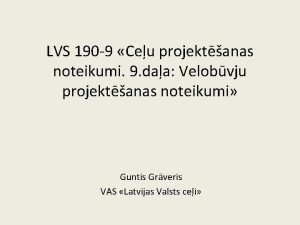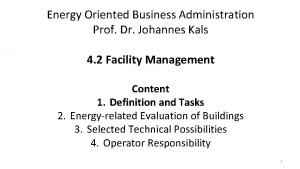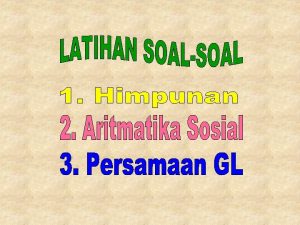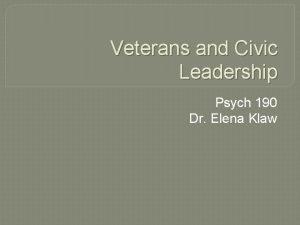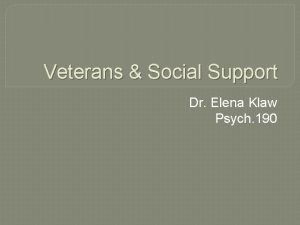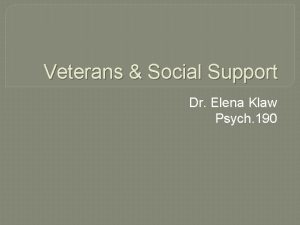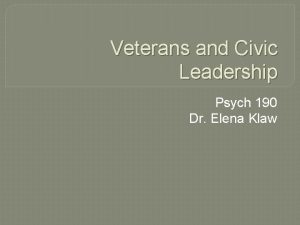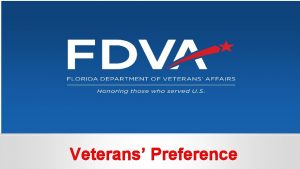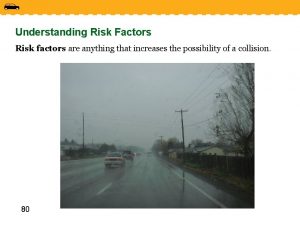Risk Factors for Veterans in Relationships Psych 190














- Slides: 14

Risk Factors for Veterans in Relationships Psych. 190 Dr. Elena Klaw

Goals for Today �Blue Shield Study �Hypothesis development �Risk Factors for IPV �Findings �Interventions �Veterans’ goals in Warriors at Home Class �Effects of class �Conclusions

Blue Shield Study on Barriers to Healthy Relationships & Risk Factors for IPV in Veterans (Klaw, Demers, & Da Silva) Procedures v Veterans who had served in the military since 9/11/01 were recruited from California State Universities. v Participants completed anonymous, electronic surveys that using standardized measures to assess psychological distress, anger, alcohol use and drug use, hypermasculinity, social support, adherence to domestic violence (DV) myths, and conflict tactics. � Participants v 131 male participants completed the surveys. Participants ranged in age from 19 -50, with a mean age of 29. 3 and represented all branches of service.

Hypothesis Development �What Risk Factors Would Increase the Likelihood of IPV in Vets?

Risk Factors for Intimate Partner Violence � Although overall means suggested low rates of distress and partner violence, high risk groups emerged. � 36% met criteria for alcohol use disorder. � 27% had used drugs for nonmedical reasons. � 10% endorsed at least some psychological distress. � Over 25% endorsed DV myths. � 28% had insisted on sex with their partner.

Relationship Problems Reported by College Student Vets � � � � � 55% noted “moderate” to a “huge amount” of anger 38% feel lonely 36% reported problems in their relationship 34% reported low social support 26% no close friends 68% insulted or swore at partner 67% had shouted at partner 12% threatened to hit or throw something at partner 12% had grabbed their partner 10% destroyed thing of partner.

Examining Correlations & Regression Analyses �Results suggest that higher levels of psychological distress and hypermasculine attitudes increase the likelihood of anger, psychological aggression, violence supportive attitudes, and sexual coercion towards a partner.

Interventions �Building on the success of the Healthy Relationship Discussion Group Series, a class was designed to address transition issues for veterans. �Goals of the course were to enhance veterans’ success in life post deployment/separation from the military, in having healthy relationships, and in college.

Evaluation of Warriors at Home Class for Vets v 8 of 9 military students in the undergraduate course, Warriors at Home, completed open-ended assessments. Seven students were male, one was female. Procedures v Pre-test, early-semester, mid-semester, and post-test openended assessments were administered. Analyses v Responses were analyzed iteratively, used a grounded theory approach, (Straus & Corbin, 1990), and recurring themes were identified by the researchers.

Expressed By Student Veterans v 62. 5% of the veteran students expressed the • desire to learn about Campus Resources and the benefits provided to them. “Gain knowledge in how to obtain and/or acquire tools to become more successful as a student. ” v 25% of the student veterans reported Emotional • Stability as something they wanted to work on. “I am still prone to aggressive behavior. I would like to change this”

Early Semester: Goals Expressed By Student Veterans v • • 57% of the student veterans felt they would like to address and work on Stressors throughout the semester. “It seems as if in the military I built endurance for high levels of stress, but cannot handle the least bit of stress. ” “My biggest problem with me is at worst I have a shutdown reaction when things become overwhelming. ” 43% of the student veterans specifically reported wanting to address Anger and Anxiety. “For me, stress brings anxiety and anxiety brings depression. ” “I unquestionably get anger quicker and tend to snap at the small things more often”

End of Semester Feedback: Effects of the Class v 87. 5% of the student veterans felt this class had a Positive Effect. • “Honestly this class has also helped. It is always nice hearing that we are not alone and I believe our classmates will help each other achieve new goals. ” • “Definitely will help me move forward as a better person. ”

Specific Effects of Class v 62. 5% of the class reported this class benefitted their ability to engage in relationships, share about past, and learn more about PTSD. • • “Helped me identify triggers” “It helped me to better understand communicate in my personal relationships. ”

Conclusion � Veterans benefit from specific classes that pertain to transition issues and healthy relationships. . � Students hoped to see the course offered as a GE so that it would “count. ” � The Warriors at Home Class was most relevant to individuals who had been deployed, and needed to be modified to meet the needs of other military members and significant others. � Longitudinal studies of graduation rates, college engagement, and satisfaction in veterans who participate in vet specific programs vs. those that don’t is essential.







